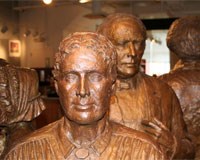
NPS Jane Clothier Master Hunt was born in Philadelphia, Pennsylvania, on Jane's marriage at age thirty-three made her the step-mother of three older children, all born to Richard's third wife, Sarah M'Clintock In 1850, the Hunt household, like those of many other signers, included not only Jane and Richard Hunt and their children but also three non-related members. George Hunter was an Irish-born laborer, aged thirty. Ann McClelland, also Irish-born, was twenty-five. Both probably worked in the Hunt household. Elizabeth Kinnard, only thirteen years old, also lived with the Hunts. Jane's marriage to Richard P. Hunt made her the wife of one of the richest men in Seneca County, and their home at 6 Main Street on the Seneca Turnpike (now Routes 5 and 20), just east of the village of Waterloo, reflected their prosperity. The house was an eleven-room brick Federal-style mansion with a central hallway, old-fashioned for the 1840s but commodious. They lived in considerable comfort, with carpeted floors, upholstered sofas, rocking chairs in the sitting room and the parlor, astral lamps, window shades (probably painted) in the parlor, curtained windows in the sitting room and bedrooms, and a full complement of dinner ware, silver teaspoons, glasses, and candle sticks. They kept a horse, four carriages, and a sleigh in the barn. When several Quaker women decided to invite Lucretia Mott, a well-known minister and reformer from Philadelphia, to visit Waterloo in July 1848, Jane Hunt offered her house for the meeting. On Sunday, July 9, 1848, Mott arrived at the Hunt house with her sister, Martha Wright, from Auburn, New York. Mary Ann M'Clintock of Waterloo was also there. So was one other woman, the only non-Quaker, Elizabeth Cady Stanton. Stanton had first met Lucretia Mott at the World Anti-Slavery Convention in London in 1840, when Stanton was on her honeymoon. When the London meeting refused to admit women delegates from the U.S., Stanton remembered, the women had agreed to hold a meeting when they returned home solely to discuss the rights of women. Now, seeing Mott again after many years apart inspired Stanton once more. She "poured out her long-standing discontent," . . . . The women decided to hold a meeting "for protest and discussion." Richard P. Hunt may have encouraged this decision, for family legend suggests that, practical Quaker that he was, he reminded them that "faith without works is dead." The women decided to meet quickly, before Mott returned home to Philadelphia. Around the Hunts' tea table, they drafted a brief notice announcing, "A Convention to discuss the social, civic and religious condition and rights of Woman will be held in the Wesleyan Chapel at Seneca Falls, N. Y., on Wednesday and Thursday, the 19th and 20th of July. . . ." The notice was delivered to the offices of the Seneca County Courier in Seneca Falls, where it first appeared on Tuesday, July 11. Without that gathering of Quaker women who were experienced in the strategy and tactics of the abolition movement, energized by Stanton around Jane Hunt's tea table, there would have been no Seneca Falls convention. Richard P. Hunt died November 7, 1856, leaving Jane a widow with six children eighteen years old and younger. Jane C. Hunt continued the family's tradition of philanthropy when she gave to St. Paul's Episcopal Church the land for St. John's Chapel on the east side of Chapel Street in Waterloo. She lived in the family home until her own death while on a visit to her daughter in Chicago on November 28, 1889, aged 77. She was buried next to her husband in Maple Grove Cemetery in Waterloo. Sources:
|
Last updated: February 26, 2015
